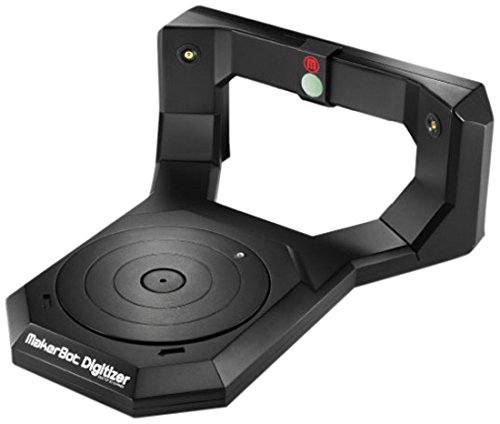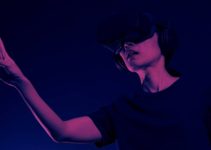IN A HURRY? CHECK OUT Ciclop 3D Scanner TOP PROS:
Are you really good with clay modeling?
Do you want to quickly replicate your work of art?
Is 3D modeling not your best skill?
Do you already own a 3D printer and want to make some money by duplicating items?
Then you might want to give 3D scanning a shot. No matter if you are an engineer, product designer, modeler, or artist, with a 3D scanner, your digital models will be done faster and more efficiently. You will be able to easily incorporate existing designs via reverse engineering, digitizing clay sculptures, or referencing the exact shape of the human body.
3D scanners can also help you detect printing errors and show you where to reinforce a deformed part in the next revision. Another cool benefit of owning a 3D scanner is that you can have your own quality control. You can easily verify the accuracy of a 3D printed model.
Because the market is full of different 3D scanner models picking the best 3D scanner for your needs can become quite tricky. Do you need a 3D desktop scanner, or is a handheld 3D scanner better suited for your specific needs?
In this article, we will help you find the best 3D scanner that suits your needs and is also on budget.
CONTENTS:
- 3D scanning and 3D printing
- Before you buy: what to consider when buying a 3D scanner
- 5 Best 3D scanners of 2020 – in-depth review
- How we choose these products
| IMAGE | PRODUCT | DETAILS | |
|---|---|---|---|
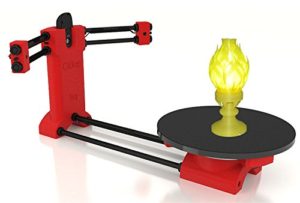 |
Our #1 Choice
Ciclop 3D Scanner |
|
Check on Amazon |
 |
Matter & Form Mfs1V2 3D Scanner V2 |
|
Check on Amazon |
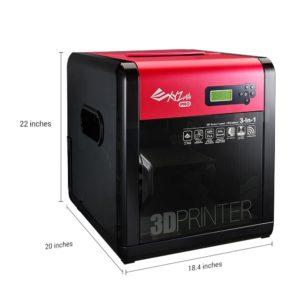 |
XYZprinting da Vinci 1.0 3D Scanner/Printer |
|
Check on Amazon |
 |
BQ Ciclop |
|
Check on Amazon |
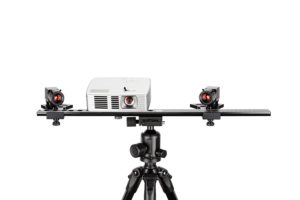 |
HP 3D Structured Light Scanner |
|
Check on Amazon |
3D Scanning and 3D Printing
By combining the technology of 3D scanning and 3D printing, you will get a robust workflow that will help you replicate the shape of almost any object. With a 3D scanner, the capabilities of your 3D printer will be expanded to the fullest potential. Simplify and sophisticate every process in a wide range of industries.
The technologies of 3D printing and 3D scanning are, in fact, inverses of each other.
A 3D scanner creates a 3D mesh of triangles, better known as polygons. Polygons are 2D triangles that build a virtual 3D model from a real object.
Basically, this means that you can easily create a virtual 3D model from any existing object. A 3D printer does the opposite. It uses virtual objects to produce real ones.
So, you can see the connection between these two 3D devices. If you want to unlock the full potential of the 3D printer, getting a 3D scanner is a wise choice. Your 3D models will become ultra-detailed and will require far less touching up.
Before You Buy: What to Consider When Buying a 3D Scanner
Before you buy a 3D scanner, it would be helpful to research how this technology works exactly.
Do you want to contact or non-contact 3D scanning? Do you have to choose between high accuracy and low price? How much scanner volume and coverage do you actually need? And many more questions.
So, let’s dive into the most essential things you should know to find the best 3D printer for your needs.
Accuracy
Accuracy refers to how detailed the virtual 3D model is compared to the real mode. The better the accuracy of a 3D scanner is, the closer you have come to replicating a real image in great detail.
The accuracy of 3D scanners varies considerably. It really depends on the technology and the price. Like with most things, the higher the price, the better the product you get.
The accuracy of 3D scanners usually ranges between 0.01mm to 0.1mm. If you need better details on your 3D model, you will need a 3D scanner with high accuracy.
Accuracy is extremely important in the industrial use of 3D scanners. Those are professional 3D scanners that offer the best specification but are very pricey.
If you want to replicate your artwork or to create a virtual model of an existing object, a 3D scanner with medium specs will suit your needs, and your wallet won’t suffer.
It basically depends on the task on hand, but the choice is all yours. Maybe investing in a professional 3D scanner isn’t a bad business idea for you.
Resolution
After accuracy, the resolution is the second most important thing to consider when looking for the best 3D scanner for you.
Resolution represents the shortest distance between any two given points in a 3D model. Resolution is usually measured in millimeters or in microns, depending on how high the resolution is.
Resolution is a crucial point in reverse-engineering, animation, virtual reality, quality control, and many other domains.
If you want your model to be as detailed as possible, a high-resolution 3D scanner is the best choice. But, take note that such a scanner won’t be the cheapest on the market.
However, a high-resolution 3D scanner will be much more massive and will take more time to process the model. In addition to that, a high-resolution 3D scanner will be a significant setback for people who don’t have a powerful computer.
So, if you have a less powerful computer, and processing time and printing speed matters to you, then a high-resolution 3D scanner isn’t the best choice for you.
The best would be to inform yourself about how high the resolution should be based on your specific use case. Maybe a portable, lightweight 3D scanner with 0.15mm resolution will be the best choice for you.
Speed
Because time is money, speed is also an essential specification when it comes to 3D scanners.
The way the speed is measured varies between the technology that the scanner is using. The speed of structured light 3D scanners is measured in the number of frames and the number of points captured in a second. Some 3D scanners range up to 16 fps and capture two million points. The speed of other types of 3D scanners is calculated by the millions of points it can catch in just one second.
With a good quality 3D scanner, you can quickly capture any given object. The faster your 3D scanner is, the more unnecessary costs will be eliminated, and your productivity will be at its maximum level.
User-friendliness
How often will you use your 3D scanner and for what purpose?
This is a crucial point to consider. Once you have answered this question, you will have a clearer image on what you are looking for in a 3D scanner.
If you need a 3D scanner for professional use, where you will do a lot of scanning and capturing a vast amount of data, then an expert device is the right choice. A professional 3D scanner will, in the long run, save you time, money and boost your productivity.
Cheaper 3D scanner models usually take some time to process the model, and the model won’t be fully detailed. Also, you will maybe need some training learning how to handle it. Some of the 3D scanners are easier, and some are trickier to handle. It can take some time to learn how to handle specific models, so you might get a bit frustrated in the process.
So, if you are quick to anger than a mid to upper-range 3D scanner is a better choice for you. The intermediate and upper-range models are quite intuitive and easy to use.
If you want your scanning to be swift and easy then you might wanna go with a 3D scanner with a fast frame rate and advanced tracking algorithm.
When talking about the post-processing stage, take note that the software is also an important part to consider. Professional scanners have very powerful software that usually contains many automated features. The software is user-friendly and fast and easy to learn. Also, the accuracy won’t be compromised.
With the price of the 3D scanner going down, keep in mind that the specifications will also go down.
If you are looking for the best 3D scanner for you in terms of user-friendliness, a mid-range 3D scanner is an excellent choice.
Portability
Are you working in a controlled environment or out in the field?
If you work in a controlled environment, a stationary 3D scanner will surely be a great solution. Stationary 3D scanners usually have a good scanner volume and coverage. This will allow you to capture large objects without any problems.
On the other hand, if you are working out on the field, a stationary 3D scanner isn’t a good option. A portable 3D scanner will, in this case, better suit your specific needs.
A portable 3D scanner is a more flexible solution. It will give you a higher degree of control over the scanning process. You will be able to capture all the hard to reach places on your model. Portable 3D scanners are also easy to manipulate and manoeuvre.
A downside of portable 3D scanners is that they require a power source that is nearby. But, there is a solution, some models allow you to use an external or internal battery.
Price
We are sure that you want to get a 3D scanner with excellent specifications, that is also on budget. The reality is that the cost will correspond to the specs of the 3D scanner, as well as the speed, data capture and quality.
The cost of 3D scanners varies between $3,000 and $100,000. Some professional scanners will even go higher than that with the price.
You might think that a cheaper 3D scanner model is the best choice, and it can be. More affordable models are an excellent choice for short term use. But, if you need a scanner for long term use, investing in a pricier model would be better. It will save you time, you will work more efficiently, and it pays off over time.
Investing some more money will also provide you with a quality device that is guaranteed to last longer and is less likely to malfunction. It will surely deliver outstanding results in long term use.
Take note that you will maybe encounter some unwanted expenses when buying a 3D scanner. Some companies will charge you additional fees like shipping, sales taxes, installation, training, technical support and warranty. So, be sure to look up more companies to ensure you have made the best choice.
The 5 Best 3D Scanners of 2020 – in-depth Review
Now that you are familiar with all the things you need to consider before you buy a 3D scanner, it is time to dive in the best 3D scanners the market has to offer.
Whether you need a portable 3D scanner for work on the field or a stationary scanner for work in a controlled environment, we have put up the best of the best.
No matter if you are a professional or a newcomer to the 3D scanning field, you will surely find a 3D scanner that suits your specific needs.
1. Ciclop 3D Scanner

This 3D scanner gives users the freedom to scan objects on their own and then place them on its platform. It is more or less like a DIY type of scanner. The net weight of the product is 6.6 pounds. The scan precision is within the range of 100-300 microns. This 3D scanner makes use of a Logitech C270 camera.
It has a dual laser setup, the lasers are arranged in a way that each laser stands on the side of the platform. When the camera and the laser combine, a notable result is produced, the laser and the camera give a total output of 500 microns. This scanner makes use of open-source software, the original software can easily be modified by anyone. It’s a scanner for everyone. You can easily create a new 3D scanner all by yourself.
Horus is popular software that controls 3D scanners. Ciclop also makes use of this software. What Horus software does is monitor communication between a scanner and a PC. It also helps in the synchronization of data, image processing, and it also helps in calibrating 3D scanners. If you’re thinking of the best software to pair with this product, Horus is your best bet.
The Logitech C270 HD camera is perfect for the Ciclop 3D scanner; it has a video capture capability of 1280 × 720 pixels. It captures still photos at 3.0MP. This camera can capture intricate and finer details of any object.
Pros
- Dual laser setup: the product has two lasers, the lasers, and the camera combines to give fine capture details up to 500 microns.
- The scanner makes use of a quality camera; it uses a Logitech C270 HD camera.
- The Ciclop 3D scanner is made of a simple design.
Cons
- Faulty parts: we must be honest, not all parts are of high quality. If you order for one, it’s not uncommon to notice missing screws and nuts.
Bottom line
It’s a basic 3D scanner. If you just want to get the job done, it’s your best bet. Another thing is that it is budget-friendly, you don’t have to take a loan to buy one. Considering the fact it is an open-source scanner, you can always upgrade to your taste. Overall, it is recommended.
2. Matter & Form Mfs1V2 3D Scanner V2
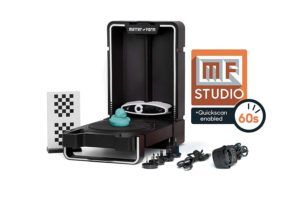
If you are looking for a 3D scanner that is suitable to use with your 3D printer, Matter & Form V2 is the right choice.
This 3D scanner comes in a modern and foldable design, so you don’t have to worry about a messy workspace. This piece of technology comes with an integrated case that will protect the camera and the turntable. You can easily fold up the base once you have finished with scanning.
Matter and Form V2 will introduce digital techniques into all your creative processes. This 3D scanner will be the bridge between the physical and the virtual, and with that drastically diversify your process.
An amazing thing with this product is that the MFS software is already included in the price. This software will allow you to go through your 3D models with ease.
Matter and Form V2 will allow you to gain full control over your scanning set-up, and you can even upgrade this to +Quickscan. With the upgrade to +Quickscan, you can complete geometry in just 65 seconds.
Pros
- Elegant and modern design
- Excellent support
- Software included in price
- Supports multiple applications
- Provides full control over scanning setup
Cons
- Long scan duration
- Needs multiple scans for best results
Bottom line
If you are an artist and want to integrate 3D objects into your art, Matter and Form V2 is made just for you. You can experiment with the design and get insight into interactive processes. It is also useful for game design because it gives you the ability to expand a virtual universe.
3. XYZprinting da Vinci 1.0 3D Scanner/Printer

This product is unique, it has a multi-functional use. It is a 3D printer, 3D scanner, and laser engraver. Our focus will be on its 3D scanning function. This product makes use of special knobs and detection software which serves as a guide and it allows for easy calibration. Item weight is 60.3 pounds. Product dimension is 27 x 23 x 21.8 inches.
This product allows anyone to wirelessly send 3D files to the printer from anywhere.
The built-in 3D scanner can rotate 360 degrees to fully capture the object. In less than 5 minutes, you can scan anything from 1 inch cubed to 5.9 Inch cubed, in 0.25mm resolution. This product is compatible with Win7 / Win8 / Mac OS X 10.8 and above.
One thing about this product is that finished scans are fully editable, you can measure, reposition, and use any post-production software to edit your scans and make any necessary adjustments. It has fully adjustable heating, speed, and retraction settings and it is equipped with an aluminum print bed for decreased chances of warpage.
Pros
- Upgradable laser engraving
- High scan resolution: you can scan anything from 1 inch cubed to 5.9 Inch cubed, in 0.25mm resolution
- Wi-Fi connectivity: The da Vinci Pro Series allows anyone to wirelessly send 3D files from their computers/ laptops
Cons
- Poor customer service
Bottom line
This product is good for those on a low budget. The da Vinci Pro 3-in-1 is the perfect machine for becoming your own manufacturer. It is easy and comfortable to use. The detection software makes calibration very easy. The scanner offers decent value for money. The product is recommended by our team.
4. BQ Ciclop
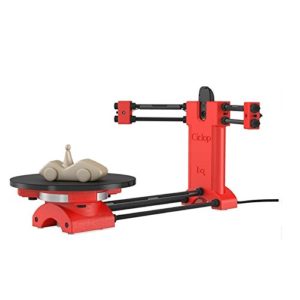
A fully open-source 3D scanner that will help you scan objects for 3D printing.
Despite its low price, the BQ Ciclop is recommended only for advanced to professional users. This is maybe a shocking fact, but there is a reason for this recommendation. This 3D scanner is quite hard to use, and only the advanced will know what to do once it arrives at your door.
Assembling this 3D printer can be quite tricky even for the more advanced users. Professional users, on the other hand, will assemble this device in under one hour.
If you want to convert your model into an STL file for printing, you will need multiple 3D scanning software.
The low cost of this 3D printer is due to its required effort, experience and knowledge to use it.
A good side of the BQ Ciclop is that all the source files for the software and hardware are available online, so you get everything you need on click.
Because this 3D scanner is so popular, you will find that there is a big supportive community of users that are willing to help if you have any problems.
Pros
- Open-source
- Low price
- Has a big supportive community
Cons
- Hard to assemble
- Best suitable for advanced and professional users
- Multiple scanning software required for converting into STL file
Bottom line
If you are an advanced user or a professional, this 3D scanner is an excellent and cheap choice. You surely won’t be disappointed. But even if you are a beginner and want to start with this scanner, go for it. There is a big community of supportive users, and you will get the hang of it in some time.
5. HP 3D Structured Light Scanner

This product is a completely modular system. It comes with a projector made by Acer. The product is also equipped with a high-grade monochrome HD camera. Additionally, the package comes with a tripod and rail setup. If you’re a newbie in the field of 3D scanning, it might be somehow difficult to assemble this product. The reason for this is that the product package contains numerous components for different purposes.
For example, the product package contains two different power adapters. One is meant for the turntable and the other for the beamer. In the package is also an HDMI cord and three USB cords. One good thing about this scanner is that it works with any PC that meets its conditions. The software designed with this product greatly benefits from the product’s RAM and fast processor.
This scanner’s cameras have high resolution, manual focus, and exposure. Do you have a rail at home? It can freely rotate on it without stress. But each time you change the position of the cameras on the rail, it must be recalibrated before you can scan again.
Before scanning with this product, we advise you to conduct a background scan beforehand, most importantly, if you are close to a wall. The scanner would be able to store the background data.
Pros
- High-resolution camera: the product is equipped with a high-grade monochrome HD camera.
- High-quality software: the software for this 3D scanner is at version 5, the interface is also user-friendly and clean.
- High level of precision: this product can produce precise results that are up to 50 microns resolution.
Cons
- Very expensive: it is being sold for $3,899.
- Not friendly to beginners
Bottom line
This product was formerly produced by a company known as DAVID. HP then later acquired the company. Ever since then, HP has invested a wealth of experience in 3D scanning. This 3D scanner produces very detailed scans. The only letdown to this product is the price. From our investigations, we found out that it is the most expensive of its kind. If you can afford it, it is highly recommended.
How we choose these products
When compiling the list of best 3D scanners of 2020, we were mainly focused on the quality of the products.
Of course, this doesn’t mean that we didn’t think about the price. This is why we gave our best at showcasing you the products from all price ranges.
There is no doubt in our mind that either one of the products above will do more than a decent job.
What do you think about 3D scanning? Is it viable? Do you own any of the products we showcased? We would like to hear your thoughts in the comments below.
YOU MIGHT ALSO LIKE:
What Is Virtual Reality Therapy?
Best VR Accessories of 2020 – Charging Stations, Sensors, And Everything In-between
